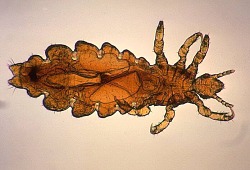Biting and Sucking Lice (Order: Phthiraptera)

The human head louse (Pediculus humanus) is commonly known as a nit.
CDC/Dr. Dennis D. Juranek
Lice are wingless ectoparasites. Ectoparasites are parasites that live on the outside of their host.
There are two main kinds of lice in the order Phthiraptera. These are the biting lice, which are most often found on birds, and the sucking lice, which are mostly found on mammals. The scientific name of the order comes from the Greek phtheir (louse) and aptera (wingless).
Biting lice
Biting lice (Mallophaga) are ectoparasites of birds, and occasionally of mammals. Their scientific name comes from the Greek mallos (wool) and phagein (to eat).
Their mouthparts are adapted for chewing, and they munch away on skin fragments, skin secretions, feathers and hair. A few species do feed on host blood, especially from existing wounds.
Bird lice are highly host specific, which means that they stick to certain species of bird. This fact has made zoologists review the evolutionary relationships and classification of some birds, because birds that share similar species of lice may be more closely related than previously thought.
Biting lice rarely have a detrimental effect on their hosts. However, in man made situations, such as chicken farms, they can occur in large numbers. In those circumstances they can cause a lot of irritation to the farmed birds, causing them to scratch a lot. The birds might then get skin infections due to the sore skin.
Sucking lice
Sucking lice (Siphunculata) have long oval bodies, and their heads are smaller than those of biting lice. Their scientific name comes from the Latin word siphunculus, which means little pipe or siphon.
Sucking lice have piercing mouthparts, which they use to suck the blood of their hosts - mostly mammals, including man. They hang on to hair with a single large claw at the end of their strong legs. Lice that feed exclusively on blood do not get a well-balanced diet, and make up for this by having bacteria in their gut that provide the additional nutrients.
Nearly every mammal species can be infested by a sucking louse - even seals and walruses have them! These 'marine lice' all belong to the family Echinophthiriidae, and they can exist for long periods under water by taking a layer of air down with them between their specially modified body hairs, or by breathing air trapped in the host's body hair.
Human lice
One of the best known lice is Pediculus humanus - the human louse - which has two distinct races. The race capitis may be found in the hair on the head, and their eggs, stuck to hairs, are termed nits. These can be very difficult and time consuming to remove - this is where the term 'nit-picking' came from.
The race corporis is found on the body. Body lice can carry diseases such as relapsing fever (caused by Borellia recurrentis) and typhus (Rickettsia prowazeki) although only if they feed on someone who already has the disease. Sucking lice on domestic animals can also spread disease.
Louse-borne disease is particularly common in wartime, when soldiers are forced to live in crowded and unsanitary conditions. Trench fever (Rickettsia quintana) was especially widespread during World War I, and was probably a major factor in the final collapse of the Russian army.
Of these two human lice, the head louse is more common, and sometimes there are outbreaks of head lice infestation in schools. Head lice can survive any amount of washing and combing, so they are not associated with lack of hygiene. Luckily, whilst head lice can be irritating, they do not carry disease.
Classification
Phthiraptera undergo incomplete metamorphosis (i.e. egg, nymph, adult) and are closely related to true bugs and booklice and barklice.
The order is divided into four suborders (Ischnocera, Amblycera, Rhynchophthirina, and Anoplura) which are differentiated by features such as the size of the head, the shape of the third antennal segment, and the presence or absence of maxillary palps.
There are around 5,000 known species worldwide, divided into 26 families. In Europe, there are some 500 species of biting lice and 50 species of sucking lice.
How to find them
The best way to find lice is by examining a recently dead host animal and combing and examining its fur. The small size of lice, and the difficulty in finding them, hasn't helped the study of this group of insects, and there is still much left to be discovered about them.
A to Z of insects
- Alderflies
- Ants
- Antlions
- Archaeognatha
- Barklice
- Bees
- Beetles
- Biting lice
- Booklice
- Butterflies
- Bugs
- Caddisflies
- Cockroaches
- Crickets
- Damselflies
- Dobsonflies
- Dragonflies
- Earwigs
- Fleas
- Flies
- Grasshoppers
- Lacewings
- Leaf insects
- Lice
- Mantids
- Mayflies
- Moths
- Praying Mantids
- Scorpionflies
- Snakeflies
- Stick insects
- Stoneflies
- Strepsipterans
- Sucking lice
- Termites
- Three-pronged bristletails
- Thrips
- True Bugs
- Wasps
- Web-spinners
- Zorapterans
- Non-insect hexapods
- Proturans
- Springtails
- Two-pronged bristletails
Back to Insect Orders.
![Amateur Entomologists' Society home page [Logo]](/images/aes-logo-wplant.gif)